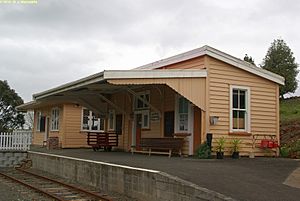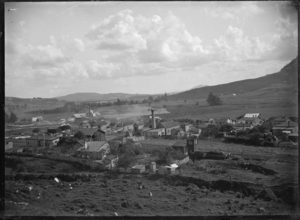Hikurangi facts for kids
Quick facts for kids
Hikurangi
|
|
|---|---|
|
Town
|
|

Hikurangi station
|
|
| Country | New Zealand |
| Region | Northland Region |
| District | Whangarei District |
| Ward | Hikurangi-Coastal Ward |
| Electorates |
|
| Area | |
| • Total | 4.00 km2 (1.54 sq mi) |
| Population
(June 2023)
|
|
| • Total | 1,780 |
| • Density | 445.0/km2 (1,153/sq mi) |
Hikurangi is a town located in the Northland Region of New Zealand. It is about 17 kilometers south of the city of Whangārei. The town is also 39 kilometers northwest of Kawakawa.
Hikurangi is surrounded by natural beauty. The Glenbervie Forest is to the southeast. A large volcanic hill called Mount Hikurangi rises 365 meters to the west. This mountain is very old, about 1.2 million years old. It is part of a larger group of volcanic features in the area. Today, Hikurangi serves as an important center for the local dairy farming industry.
Exploring Hikurangi's Past
Hikurangi has a rich history, starting with its natural resources. In 1862, a large area of land, about 12,000 acres, was bought from local Māori people. This land was valuable because it had lots of mature trees and high-quality New Zealand flax. Soon, ways to transport these resources were set up.
Timber and Gum Digging
Hikurangi became a busy place for cutting timber. A road to Whangarei was built in 1875, making it easier to move wood. Soon after, the first sawmills opened. People also worked as gum-diggers in the area, collecting valuable kauri gum from the ground.
Coal Mining Days
The town really grew when coal mines opened in 1890. A railway line from Whangarei reached Hikurangi in 1894, helping to transport the coal. Over time, about 4.2 million tons of coal were dug up from the mines.
However, the mines faced challenges, especially from flooding. In 1931, during a big strike, one mining company closed its mine and flooded it on purpose. The miners then bought the mine themselves, but it closed two years later because there wasn't much demand for coal during the Great Depression. The last coal mine in Hikurangi closed in 1971.
Dairy Farming and Local Businesses
In 1904, the Hikurangi Co-operative Dairy Company was started. They built a dairy factory and used trucks to collect cream from farms. These trucks also delivered things like fertilizer to farmers. The original factory was replaced in the 1950s. However, the company later joined with another dairy company in 1985, and the factory closed.
Town Administration and Growth
Hikurangi was first managed by a Roads Board. In 1908, a Town Board was formed to help run the town. This board became the Hikurangi Town Council in 1955. Later, in 1989, it joined with the Whangarei City Council to form the Whangarei District Council, which still manages the area today.
Limestone Quarrying
Since the early 1900s, limestone has been dug out of the ground at Hikurangi. This limestone is still used today at the cement works in Portland.
People of Hikurangi
Hikurangi covers an area of 4.00 square kilometers. As of 2023, about 1,557 people live there. This means there are about 389 people living in each square kilometer.
Population Changes Over Time
The number of people living in Hikurangi has changed over the years:
- 2006: 1,419 people
- 2013: 1,410 people
- 2018: 1,617 people
- 2023: 1,557 people
In the 2023 census, there were slightly more males (789) than females (765) living in 522 homes. The average age of people in Hikurangi was 32.5 years. This is younger than the national average for New Zealand.
Age Groups in Hikurangi
The population of Hikurangi includes people of all ages:
- About 27.2% of people were under 15 years old.
- About 19.1% were aged 15 to 29.
- About 41.4% were aged 30 to 64.
- About 12.5% were aged 65 or older.
Ethnic Backgrounds and Languages
People in Hikurangi come from many different backgrounds. The main ethnic groups include:
Most people (96.9%) in Hikurangi speak English. Some people also speak the Māori language (11.6%) and other languages. About 10.4% of the people living in Hikurangi were born outside of New Zealand.
Education and Work
For people aged 15 and older, about 9.5% have a university degree. Many others (61.9%) have a certificate or diploma from after high school. The average income in Hikurangi was $39,100. Most people aged 15 and over are employed, with 51.6% working full-time and 12.2% working part-time.
Learning in Hikurangi
Hikurangi School is a school for students from Year 1 to Year 8 (ages 5 to 13). It is a coeducational school, meaning both boys and girls attend.
Hikurangi School's History
The first public school in Hikurangi opened in 1883 on View Road. This building was later taken down in 1922. A new school was built on the current site at Valley Road between 1922 and 1923. Over the years, the school has been made bigger many times to fit more students. The old school site on View Road was sold, and a house was built there in 1923. This house is now considered a historic place.
See also
 In Spanish: Hikurangi para niños
In Spanish: Hikurangi para niños


